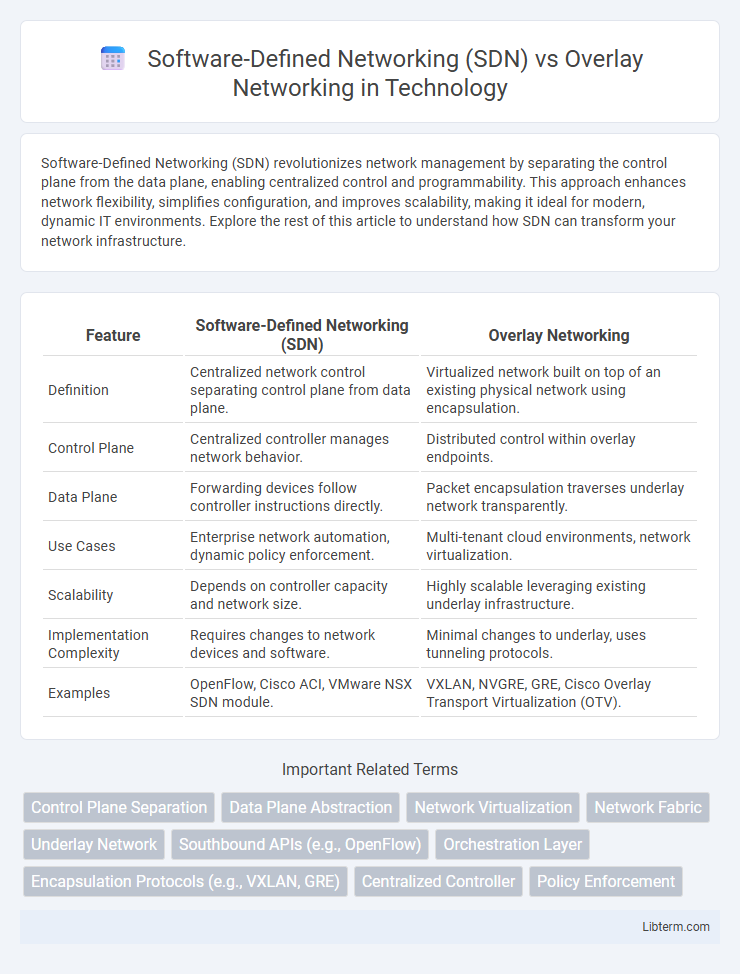Software-Defined Networking (SDN) revolutionizes network management by separating the control plane from the data plane, enabling centralized control and programmability. This approach enhances network flexibility, simplifies configuration, and improves scalability, making it ideal for modern, dynamic IT environments. Explore the rest of this article to understand how SDN can transform your network infrastructure.
Table of Comparison
| Feature | Software-Defined Networking (SDN) | Overlay Networking |
|---|---|---|
| Definition | Centralized network control separating control plane from data plane. | Virtualized network built on top of an existing physical network using encapsulation. |
| Control Plane | Centralized controller manages network behavior. | Distributed control within overlay endpoints. |
| Data Plane | Forwarding devices follow controller instructions directly. | Packet encapsulation traverses underlay network transparently. |
| Use Cases | Enterprise network automation, dynamic policy enforcement. | Multi-tenant cloud environments, network virtualization. |
| Scalability | Depends on controller capacity and network size. | Highly scalable leveraging existing underlay infrastructure. |
| Implementation Complexity | Requires changes to network devices and software. | Minimal changes to underlay, uses tunneling protocols. |
| Examples | OpenFlow, Cisco ACI, VMware NSX SDN module. | VXLAN, NVGRE, GRE, Cisco Overlay Transport Virtualization (OTV). |
Introduction to Software-Defined Networking (SDN)
Software-Defined Networking (SDN) centralizes network control by separating the control plane from the data plane, enabling dynamic, programmable network management through software applications. This architecture enhances network flexibility, automation, and scalability, supporting rapid deployment of services and real-time traffic optimization. Unlike overlay networking, which creates virtual networks on top of existing infrastructure, SDN provides direct control over physical network devices, improving interoperability and policy enforcement.
Overview of Overlay Networking
Overlay networking creates a virtual network layered on top of an existing physical network, enabling simplified management and enhanced flexibility for applications and services. It abstracts the underlying infrastructure by encapsulating network traffic within tunnels such as VXLAN or GRE, allowing seamless connectivity across diverse and geographically dispersed data centers. Overlay networks facilitate rapid deployment, dynamic scalability, and improved isolation, making them ideal for cloud computing and multi-tenant environments.
Core Architecture Differences
Software-Defined Networking (SDN) centralizes network control by separating the control plane from the data plane, enabling programmable network management through a centralized controller that directly interacts with underlying physical devices. Overlay Networking, by contrast, creates virtual networks on top of existing physical infrastructure using encapsulation protocols like VXLAN or GRE, allowing independent control of virtualized network segments without altering the underlying hardware. SDN emphasizes a global view and dynamic programmability through a singular control plane, while Overlay Networking focuses on abstraction and isolation by decoupling virtual network topologies from physical network constraints.
Control and Data Plane Separation
Software-Defined Networking (SDN) centralizes control plane functions, enabling programmable network management while separating it from the data plane that handles packet forwarding. Overlay Networking creates virtual networks by encapsulating traffic over existing infrastructure, often decoupling control logic from the physical data plane without fully centralizing control. SDN offers granular control through a centralized controller, whereas Overlay Networking provides flexible, tenant-specific virtual topologies operating independent of the underlying hardware's native control mechanisms.
Scalability and Flexibility Comparison
Software-Defined Networking (SDN) enhances scalability by centralizing control plane functions, enabling dynamic resource allocation and simplified network management across large data centers and enterprise environments. Overlay Networking improves flexibility through virtualized, decoupled network layers that allow rapid deployment of isolated, customizable virtual networks over existing physical infrastructure without altering underlying hardware. SDN excels in scalability by providing programmable, centralized control suitable for extensive network topologies, while Overlay Networking offers superior flexibility for creating tenant-specific policies and network segmentation in multi-tenant cloud environments.
Security Considerations in SDN and Overlays
Software-Defined Networking (SDN) centralizes network control, improving security through programmable policies and real-time threat detection, but introduces risks like controller-targeted attacks and misconfigurations. Overlay networking enhances security by isolating traffic within virtual tunnels and encrypting data across physical infrastructures, yet it relies heavily on the security of underlying networks and tunnel endpoints. Both SDN and Overlay architectures require robust authentication, authorization, and continuous monitoring to mitigate vulnerabilities in their distinct control and data plane interactions.
Performance and Latency Analysis
Software-Defined Networking (SDN) centralizes network control to optimize traffic paths, reducing latency by enabling dynamic load balancing and minimizing bottlenecks. Overlay Networking abstracts the physical network through encapsulation, often introducing additional processing overhead and potential latency due to tunneling and packet encapsulation. Performance metrics typically show SDN achieving lower latency and higher throughput in environments requiring real-time traffic management, while Overlay Networks provide greater flexibility at the cost of increased packet overhead.
Use Cases and Deployment Scenarios
Software-Defined Networking (SDN) excels in centralized network management and dynamic traffic control, making it ideal for data centers and large enterprise networks requiring granular policy enforcement and real-time network optimization. Overlay Networking, leveraging virtual tunnels over existing infrastructure, is best suited for multi-cloud environments, enabling secure and scalable connectivity across distributed locations without altering the underlying physical network. Deployment scenarios for SDN include high-performance cloud services and network function virtualization, while Overlay Networking is commonly deployed in hybrid cloud architectures and remote branch connectivity.
Management and Orchestration Challenges
Software-Defined Networking (SDN) centralizes network management through a single controller, enabling dynamic configuration and streamlined orchestration of physical network devices. Overlay Networking operates on top of existing infrastructure using virtual tunnels, complicating management due to abstracted layers and potential inconsistencies between the overlay and underlay networks. Both approaches present orchestration challenges, including ensuring policy consistency, troubleshooting multi-layered connectivity issues, and integrating heterogeneous devices across distributed environments.
Future Trends: SDN and Overlay Networking Integration
Future trends indicate a growing integration of Software-Defined Networking (SDN) and Overlay Networking to enhance network agility, scalability, and centralized control. This convergence facilitates dynamic resource allocation and improved network automation through unified management of physical and virtual infrastructures. Advancements in AI-driven orchestration and intent-based networking are expected to further optimize the combined SDN-overlay environments for complex, multi-cloud deployments.
Software-Defined Networking (SDN) Infographic

 libterm.com
libterm.com